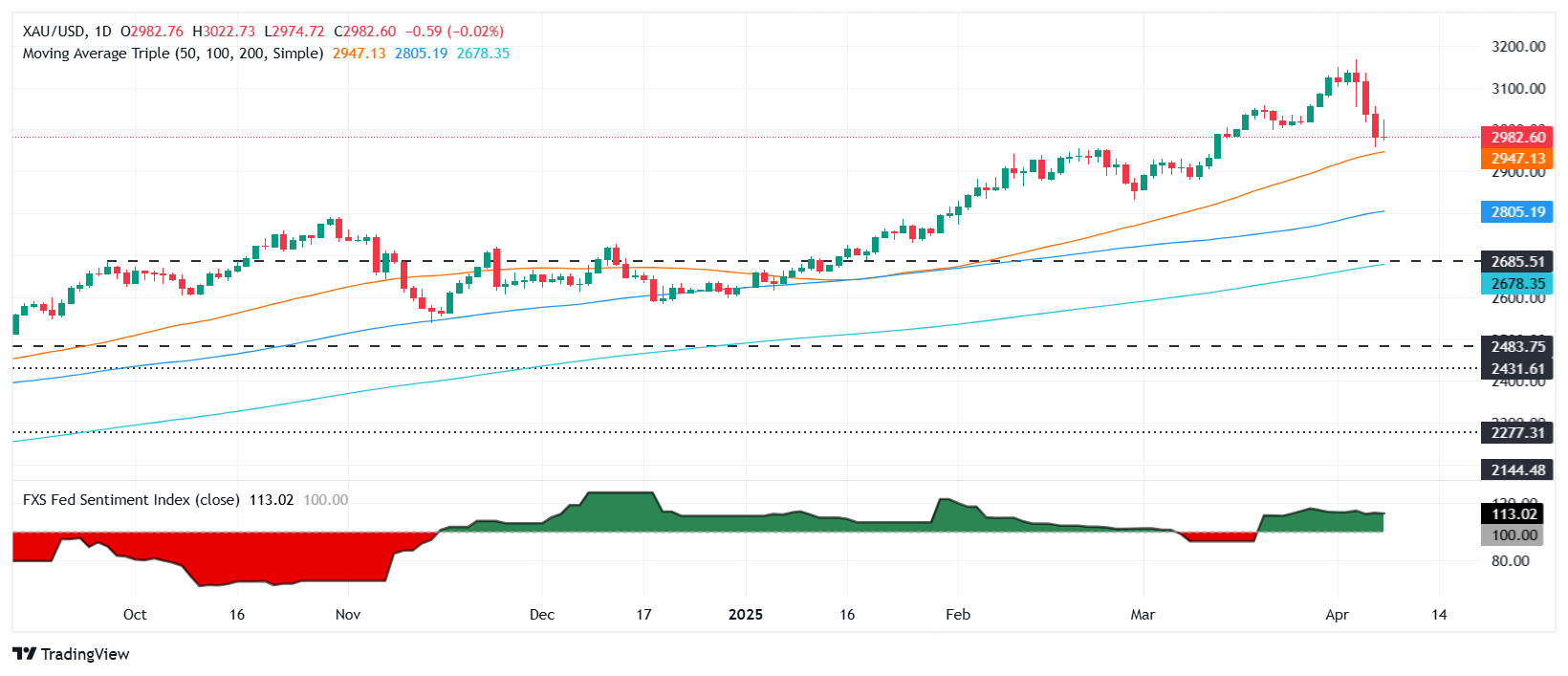Created
: 2025.04.09














![]() 2025.04.09 07:13
2025.04.09 07:13
Gold price snaps three days of losses, consolidates below the $3,000 figure as US Treasury yields rise, making the non-yielding metal less appealing for investors. Even though there are hopes of trade deals between partners, the "trade war" between the US and China makes investors uneasy. At the time of writing, XAU/USD trades at $2,980 a troy ounce, virtually unchanged.
Sentiment shifted to negative as Wall Street registered substantial losses. Monday's rally was short-lived as the bear market resumed, with the Volatility Index (VIX) pushing once again toward higher levels, indicating that market participants remain uncertain about the economic outlook.
The White House's announcement that the US would keep 104% tariffs on China triggered a spike in the VIX. Consequently, the S&P 500, the Dow Jones, and the Nasdaq erased their earlier gains and plunged on Tuesday.
Nevertheless, Gold prices tumbled as US Treasury yields spiked across the whole yield curve. The swaps market had priced in a 40% chance of a Fed rate cut in May. Despite this, elevated US yields continue to pressure XAU/USD.
In the meantime, Federal Reserve officials crossed the newswires. San Francisco Fed Mary Daly said that CEOs feel uncertain but optimistic about growth. She is concerned about a pickup in inflation due to tariffs. Earlier, Chicago Fed Austan Goolsbee said that tariffs are much higher than expected, adding there's anxiety that high inflation will return.
Traders are eyeing the release of the Fed's last meeting minutes, which would be overshadowed by the latest inflation figures on the consumer and producer sides.
Gold price stabilized near the $2,980, though price action suggests that traders are not finding acceptance past the $3,000 figure. Failure to achieve a daily close above the latter, could trigger a test of the 50-day Simple Moving Average (SMA) at $2,947. A breach below that level could drive XAU/USD towards the $2,900 mark ahead of the 100-day SMA at $2,805.

Gold has played a key role in human's history as it has been widely used as a store of value and medium of exchange. Currently, apart from its shine and usage for jewelry, the precious metal is widely seen as a safe-haven asset, meaning that it is considered a good investment during turbulent times. Gold is also widely seen as a hedge against inflation and against depreciating currencies as it doesn't rely on any specific issuer or government.
Central banks are the biggest Gold holders. In their aim to support their currencies in turbulent times, central banks tend to diversify their reserves and buy Gold to improve the perceived strength of the economy and the currency. High Gold reserves can be a source of trust for a country's solvency. Central banks added 1,136 tonnes of Gold worth around $70 billion to their reserves in 2022, according to data from the World Gold Council. This is the highest yearly purchase since records began. Central banks from emerging economies such as China, India and Turkey are quickly increasing their Gold reserves.
Gold has an inverse correlation with the US Dollar and US Treasuries, which are both major reserve and safe-haven assets. When the Dollar depreciates, Gold tends to rise, enabling investors and central banks to diversify their assets in turbulent times. Gold is also inversely correlated with risk assets. A rally in the stock market tends to weaken Gold price, while sell-offs in riskier markets tend to favor the precious metal.
The price can move due to a wide range of factors. Geopolitical instability or fears of a deep recession can quickly make Gold price escalate due to its safe-haven status. As a yield-less asset, Gold tends to rise with lower interest rates, while higher cost of money usually weighs down on the yellow metal. Still, most moves depend on how the US Dollar (USD) behaves as the asset is priced in dollars (XAU/USD). A strong Dollar tends to keep the price of Gold controlled, whereas a weaker Dollar is likely to push Gold prices up.
![]()
Created
: 2025.04.09
![]()
Last updated
: 2025.04.09

FXStreet is a forex information website, delivering market analysis and news articles 24/7.
It features a number of articles contributed by well-known analysts, in addition to the ones by its editorial team.
Founded in 2000 by Francesc Riverola, a Spanish economist, it has grown to become a world-renowned information website.
We hope you find this article useful. Any comments or suggestions will be greatly appreciated.
We are also looking for writers with extensive experience in forex and crypto to join us.
please contact us at [email protected].
Disclaimer:
All information and content provided on this website is provided for informational purposes only and is not intended to solicit any investment. Although all efforts are made in order to ensure that the information is correct, no guarantee is provided for the accuracy of any content on this website. Any decision made shall be the responsibility of the investor and Myforex does not take any responsibility whatsoever regarding the use of any information provided herein.
The content provided on this website belongs to Myforex and, where stated, the relevant licensors. All rights are reserved by Myforex and the relevant licensors, and no content of this website, whether in full or in part, shall be copied or displayed elsewhere without the explicit written permission of the relevant copyright holder. If you wish to use any part of the content provided on this website, please ensure that you contact Myforex.
Myforex uses cookies to improve the convenience and functionality of this website. This website may include cookies not only by us but also by third parties (advertisers, log analysts, etc.) for the purpose of tracking the activities of users. Cookie policy